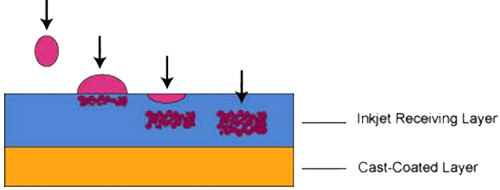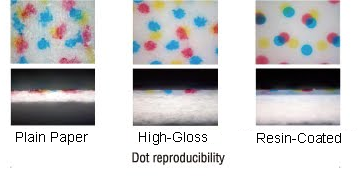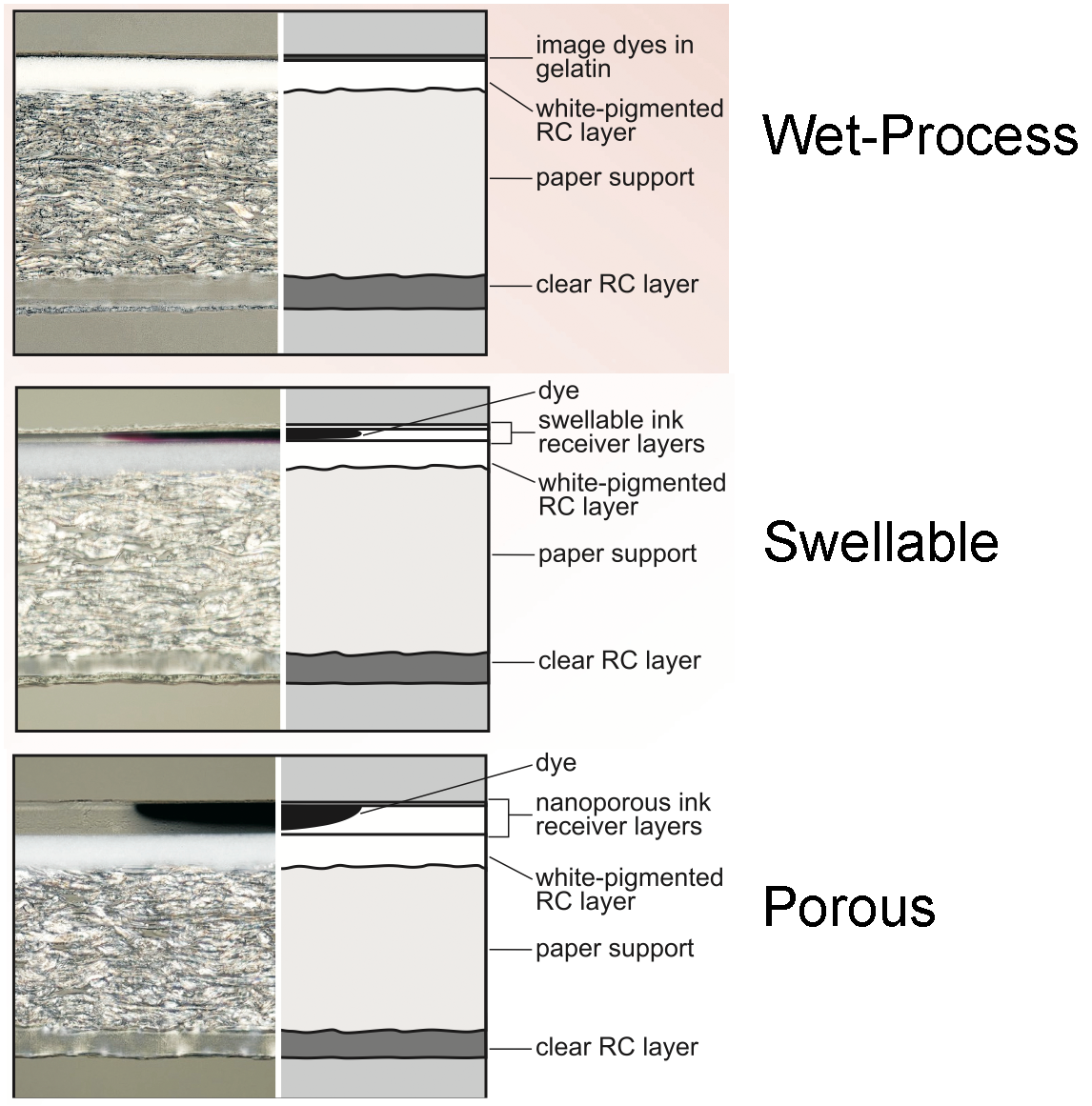Picking The Best Ink And Paper For Your Inkjet Printer
The subject of printing has the potential to be super boring. But it's fun to break technologies down and explore how they work. If you're a true techie, you'll dig the tests we're performing to get the best quality out of our inks and printer paper.
Deciphering Photo Paper
Stepping up to true photo-quality artwork requires photographic paper, which you can generally break down into three groups.
- Matte Photo Paper
- High-Gloss Photo Paper
- Resin-Coated Photo Paper
Matte Photo Paper
Matte photo papers are better suited for well-lit environments or situations where you want the widest viewing angles. The lack of a glossy finish means that you're not going to get any glare (great for black and white pictures or a newspaper effect).
With that said, you need to understand the advantages and disadvantages.
| Matte Photo Paper | |
|---|---|
| Advantages | Disadvantages |
| Quick-drying because ink is absorbed into the paper pulp | Prone to light fade because there's no protective coat |
| Compatible with a wide range of printers and large pigment molecules will be directly absorbed into paper | Prints will feel light due to a lack of a paper base |
| Row 3 - Cell 0 | Paper is easy to tear and crinkle |
| Row 4 - Cell 0 | Images can appear less sharp due to absorption into pulp layer |
High-Gloss Photo Paper
High-gloss photo paper feels more like a sheet of heavy stock matte paper than it does true photo paper. Generally speaking, it's cheaper than the best photo paper, but it offers more color vividness than matte photo paper.
List of High-Gloss Photo Paper
Get Tom's Hardware's best news and in-depth reviews, straight to your inbox.
- Epson Photo Paper Glossy
- Epson Ultra Premium Photo Paper Glossy (high-gloss with base)
- Canon Photo Paper Glossy
- HP Premium Photo Paper Glossy
- Kodak Photo Paper Gloss
| High-Gloss Photo Paper | |
|---|---|
| Advantages | Disadvantages |
| Relatively fast drying because ink settles in top layer | Still suffers from fade |
| Brighter white than matte photo paper | Some sharpness loss in pictures due to ink bleed |
| Semi-water resistant due to top coat | Not good for pigment inks |
| Heavier stock makes it easier to handle | Row 4 - Cell 1 |
| Relatively cheap photo paper | Row 5 - Cell 1 |
Resin-Coated (RC) Photo Paper
Resin-coated photo paper is the most expensive of all photo papers, but it also gets you the best results. Not only are your prints waterproof, but they're also full of color and at their sharpest.
| Resin-Coated Photo Paper | |
|---|---|
| Advantages | Disadvantages |
| Sharpest detail | Expensive |
| Extreme vividness | Row 2 - Cell 1 |
| Brighter white than matte photo paper | Row 3 - Cell 1 |
| Waterproof | Row 4 - Cell 1 |
| Good fade resistance | Row 5 - Cell 1 |
| Near-perfect saturation | Row 6 - Cell 1 |
| Resistant to tears and kinks | Row 7 - Cell 1 |
Not all resin-coated photo papers are created the same. For example, photo labs and kiosks where you submit digital images for later pick-up use wet-process photo paper. This is probably the best of the best in terms of quality, but it involves time-intensive process employing a darkroom and special equipment. Obviously, that isn't something you can do at home. But you can get close with paper you pull off the shelf. You just need to know the differences between the two types of resin-coated photo papers: swellable and porous.
Both types have a resin coat on the top and bottom, which makes prints waterproof. That's where the similarities end, though. Swellable resin-coated photo paper can only be used with dye-based inks, as pigments are too large to be absorbed. This allows swellable to be much glossier than porous paper. And since the ink is restricted to the top coat, the print is more resistant to abrasions or fade from airborne pollutants. The problem is that you need to wait several hours for the print to dry. If you handle the pictures while they're still wet, the dye smears and you end up with a blurry print.
Porous resin-coated photo paper actually refers to three sub-types: macro-, micro-, and nano-porous. All three have small pores that absorb ink, but they differ in the composition of the coating and size of the pore. Generally speaking, nano-porous photo paper appears glossier than the macro or micro papers. Smaller pores are difficult to produce, though, which is why nano-porous paper often costs more.
Regardless of pore size, you can use this paper with dye- and pigment-based inkjet printers, but the prints are not as glossy as what you get with swellable photo paper. Another problem is that the pores stay open, which leaves the print vulnerable to scratches, fading, and environmental contaminants.
Manufacturers often don't tell you if their paper is swellable or porous, but there's usually a clue or two in the description. Porous papers are advertised as "instant dry," while swellable papers are usually listed as "fast-drying" or "high-gloss."
| Resin-Coated Photo Paper | Advantages | Disadvantages |
|---|---|---|
| Swellable | High image quality, very glossy | Less common, slow drying, incompatible with pigment inks |
| Porous | High image quality, near-instant dry times | Not as glossy as swellable, more sensitive to abrasion and fade |
| Traditional Wet-Process | Long life | Complicated to process |
List of resin-coated photo paper:
- Epson Premium Photo Paper Glossy (porous)
- Epson Premium Photo Paper Semi-Gloss (porous)
- Epson Ultra Premium Photo Paper Luster (porous)
- HP Premium Plus Glossy Photo Paper (swellable)
- HP Premium Plus Soft-Gloss Photo Paper (swellable)
- HP Advanced Glossy Photo Paper (porous)
- Canon Photo Paper Pro II (porous)
- Canon Photo Paper Platinum (porous)
- Canon Photo Paper Plus Glossy II (porous)
Current page: Deciphering Photo Paper
Prev Page Matte Paper: Look For ColorLok Next Page Test Your Ink: Bleed Resistance-
mayankleoboy1 the most interesting thing in this article was the B&W sunlight photo on the third page. awesome photo. can we have some more?Reply -
cmcghee358 I'm not gonna lie, I didn't read this. I read probably 90% of Toms articles because even though they are technical, they are still interesting. The title of this simply turned me off.Reply -
kalidasa Thanks for telling me how I can find my own quality inks and paper for printing. Now I can spend hundreds of dollars testing out the "thousands", as you put it, of third-party suppliers of printing materials.Reply
paraphrase of this article: We don't endorse buying first party, brand-name inks and paper; we're just here to tell you the extremes you can go through to find an alternative! p.s. HP is great! -
iam2thecrowe there is only one simple answer to "what is the best ink/paper for my printer". The answer is only the manufacturer of the printer makes the correct ink that and paper suitable for the printer that will yield consistantly good results for photos and prevent the head from getting clogged. The manufacturer pre-sets settings in the driver to deliver the right amount of a particular ink to a particular weight/absorbancy of paper. Use those presets with other paper/ink and you will get varied results. When you work fixing printers for a few years you will understand this is fact, not just manufacturers trying to sell overpriced ink. And you also have to remember that overpriced ink is there to make up for the losses they make on low end $50 printers.Reply -
TonyJ No mention of Ilford paper and Hobbicolor ink. Very basic overview... Try the photo printing forums for better advice.Reply -
I switched from using vendor inks a long time ago due to the massive cost of a full set of 8 cartridges (approx £25 each) and as most of my printing is general documentation the extra cost cannot be justified. When the printer isn't used for a few weeks/months the heads do clog but this also happened with the vendor inks and wasting the expensive ink to run the cleaning program and the test page is just painful to watch, this is a fraction of the cost with the non-vendor inks.Reply
Fade can be an issue on the photos that are left in direct sunlight (conservatory) but there is always the option to take the image to a kiosk for a better quality print, or simply print a different picture for the frame.
I don't keep large collections of printed photos in albums so I guess I might think differently if I did.
-
mayankleoboy1 i feel this article was just to fill the gap between something big thats coming up tomorrow or by monday.Reply
could it be BD? you guys probably have a sample but it must be under NDA -
Arbie More than print quality, my biggest problem is that the cartidges go dry = empty all by themselves, just sitting there for a few weeks. This is in a Canon ip-4000 printer. Leakage of so much ink would be obvious, so it isn't that. It just disappears. I live in a dry climate, but all of the ink including pigment is gone so it doesn't seem to be evaporation. It's as if the cartridges had simply been used up, which I know hasn't been done since only I have access to the printer.Reply
==> Does anyone else have this problem? Put in all new cartridges, print two or three pages, let it sit for several weeks and then find one or two cartridges almost empty? BTW I'm using cheap ebay cartridges, and don't plan to spend the money it would take to install a set of Canon units unless that's known to be the cure. I can't remember how the first set of (Canon) cartridges fared.
Thx - Arbie -
TonyJ Arbie...my biggest problem is that the cartidges go dry = empty all by themselves... - ArbieReply
Make sure to turn your printer off when you aren't using it. If it cycles on and off with your computer, it will cycle through its cleaning process each time. That could be your problem...





